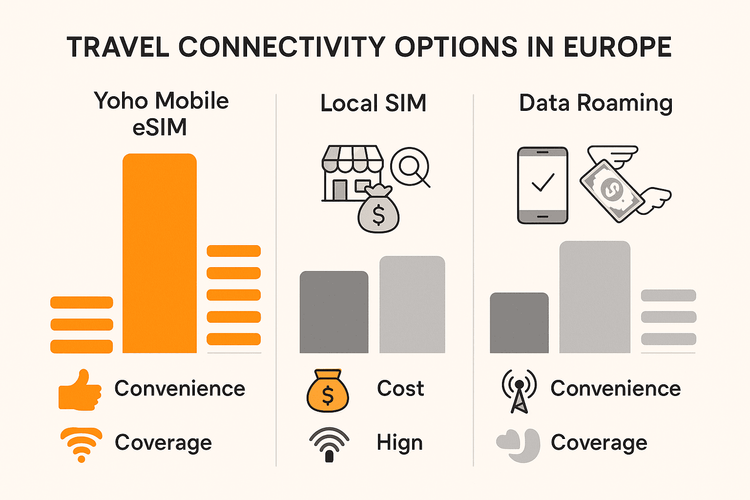Venturing into your first backpacking trip across Europe is an electrifying rite of passage. The thought of ancient cobblestone streets, breathtaking alpine views, and bustling city squares is enough to make anyone want to pack their bags immediately. But this excitement can sometimes lead to rookie mistakes. To help you navigate your journey like a seasoned pro, we’ve dived deep into thousands of posts on Reddit’s r/solotravel and r/backpacking communities. Here are the top 10 mistakes first-timers make and how you can sidestep them for the adventure of a lifetime.
Before you even book your flight, ensure your digital life is as ready as your backpack. Start your European adventure with seamless connectivity by exploring Yoho Mobile’s Europe eSIM plans today!
1. Overpacking Your Life into a Backpack
It’s the most classic mistake in the book. You imagine needing a different outfit for every possible scenario, and before you know it, your bag weighs a ton. Lugging a heavy backpack through train stations and up hostel stairs is exhausting and completely unnecessary.
How to Avoid It: Embrace minimalism. Pack versatile clothing that you can layer. Think merino wool for temperature regulation, a few neutral-colored tops, one pair of reliable walking shoes, and a smarter alternative. Roll your clothes to save space. Remember, you can always buy something you truly need there. For a detailed guide, check out this essential packing list for Europe.
2. Neglecting Your Connectivity Plan
Relying on spotty café Wi-Fi or facing shocking data roaming bills can instantly ruin a travel day. Many first-timers underestimate how much they’ll rely on their phone for maps, translations, bookings, and staying in touch. Public Wi-Fi is often slow, unreliable, and poses significant security risks.
How to Avoid It: Secure your connection before you leave with a travel eSIM. An eSIM from Yoho Mobile activates the moment you land, giving you high-speed data across multiple countries without the hassle of swapping physical SIM cards. You can choose from flexible data plans for Europe that match your trip’s length and data needs, ensuring you only pay for what you use. Plus, it’s a simple step to ensure your device is ready for the adventure; check our up-to-date eSIM compatible device list to confirm.

3. Creating a Hyper-Rigid Itinerary
Planning is smart, but scheduling every single hour of your trip is a recipe for stress. Europe is full of wonderful, unexpected detours. A rigid plan leaves no room for spontaneity—like joining new friends from your hostel on a day trip or lingering longer in a city you’ve fallen in love with.
How to Avoid It: Plan your key destinations and transport between them, but leave your daily schedules open. Book your first couple of nights’ accommodation, but allow for flexibility later in your trip. Some of the best travel memories come from unplanned adventures.
4. Underestimating Your Budget
Europe can be more expensive than you think, especially in popular Western European cities like Paris, London, and Amsterdam. Forgetting to account for things like city taxes, public transport costs, and unexpected entry fees can drain your funds quickly. This is a common pitfall for students and those on a tight budget.
How to Avoid It: Research the average daily costs for your chosen countries on sites like Hostelworld. Use a travel budgeting app to track your spending. Look for free museum days, take advantage of free walking tours, and eat at local markets to save money. A cost-effective data plan also helps, preventing surprise roaming charges from eating into your budget.
5. Sticking Only to Major Tourist Capitals
While Rome, Paris, and Barcelona are incredible, they represent only a fraction of what Europe has to offer. Focusing solely on these mega-cities means you’ll miss out on the unique charm and authenticity of smaller towns and rural areas, often with fewer crowds and lower prices.
How to Avoid It: For every major city on your list, try to add a smaller town nearby. From Prague, take a trip to Český Krumlov. After visiting Florence, explore the beautiful villages of Cinque Terre. You’ll gain a much richer perspective on the country’s culture.

6. Misunderstanding the Transport System
Europe’s transport network is fantastic, but it can be confusing for newcomers. Not booking trains in advance, underestimating travel times between destinations, or not knowing the difference between a Rail Pass and individual tickets can lead to wasted time and money.
How to Avoid It: Use platforms like Omio or Trainline to compare and book train, bus, and flight tickets. For long distances, book high-speed trains well in advance for the best prices. For extensive train travel, a Eurail Pass might be cost-effective. Always validate your ticket before boarding to avoid hefty fines.
7. Ignoring Local Customs and Scams
Assuming etiquette is the same everywhere is a quick way to appear disrespectful. Furthermore, tourist-heavy areas are often hotspots for common scams. Being unaware can make you an easy target, which is a major concern, especially if you’re navigating solo travel in Europe for the first time.
How to Avoid It: Do a quick search on local customs before arriving. Learn a few basic phrases like “Hello,” “Please,” and “Thank you” in the local language. Be wary of common scams like the “friendship bracelet” or “gold ring” trick. Keep your valuables secure and be aware of your surroundings, especially in crowded places.
8. Forgetting Power Adapters and Battery Packs
Your phone is your lifeline for maps, tickets, and communication. Finding it dead with no way to charge it is a nightmare scenario. Different countries in Europe use different plug types (the UK and Ireland are different from mainland Europe), a fact many first-timers overlook.
How to Avoid It: Invest in a universal travel adapter. More importantly, carry a fully charged portable power bank with you at all times. This little device will be a lifesaver on long train journeys or days spent exploring far from your accommodation.
9. Trying to “Conquer” Europe in One Go
A classic first-timer mistake is cramming too many countries into too short a time. A two-week trip covering ten countries will leave you exhausted and with only a superficial experience of each place. You’ll spend more time in transit than actually enjoying your destinations.
How to Avoid It: Focus on quality over quantity. Pick a region, like the Iberian Peninsula (Spain and Portugal) or Central Europe (Czechia, Austria, Hungary), and explore it more deeply. You’ll have a more relaxing and meaningful trip, with plenty of reasons to return.
10. Not Having a Data Backup Plan
Picture this: you’re navigating a new city, your data plan unexpectedly runs out, and you’re completely lost. It’s a stressful situation that can derail your day. Relying on a single plan without a safety net is a risky gamble.
How to Avoid It: This is where Yoho Mobile’s unique Yoho Care feature provides ultimate peace of mind. Even if you use up all your high-speed data, Yoho Care ensures you’re not cut off completely. It provides a basic data connection so you can still use messaging apps, access maps, or manually top up your plan. You’ll never be left stranded. Learn more about the peace of mind offered by Yoho Care.
Frequently Asked Questions (FAQ)
Q: What is the biggest mistake first-time travelers make in Europe?
A: Overpacking is arguably the most common mistake. It leads to physical strain and unnecessary hassle. The second biggest is not having a reliable mobile data plan, which can lead to getting lost, being unable to access bookings, and incurring high roaming charges.
Q: How much money should I budget for a backpacking trip in Europe?
A: A common backpacking budget for Europe is around €50-€80 per day, depending on the region. Eastern Europe is generally more affordable than Western Europe. This should cover hostel accommodation, food, transport, and some activities. Always have an emergency fund set aside.
Q: Is it safe to travel solo in Europe as a first-timer?
A: Yes, Europe is generally very safe for solo travelers, including first-timers. Just take standard precautions: be aware of your surroundings, secure your belongings, don’t walk alone in unlit areas at night, and let someone back home know your itinerary. A reliable data connection is a key safety tool.
Q: How can I get cheap mobile data while backpacking through Europe?
A: An eSIM is the most convenient and cost-effective solution. With an eSIM from Yoho Mobile, you can buy affordable, regional data packages before you even leave home. This helps you avoid expensive roaming fees and the inconvenience of finding and registering a local physical SIM card in every new country.
Conclusion
Your first backpacking trip to Europe should be about making incredible memories, not frustrating mistakes. By packing smart, planning flexibly, staying aware, and most importantly, ensuring you’re always connected, you set yourself up for success. Sidestepping these common pitfalls will transform your trip from a stressful scramble into the adventure of a lifetime.
Ready to tick “stay connected” off your prep list? Customize your perfect Europe travel plan with Yoho Mobile’s flexible eSIMs and travel with confidence!
